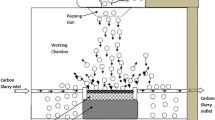Abstract
This research program was carried out to evaluate the effects of surface hardening on the fracture toughness of carburized steel. The materials AISI 8620 steel was machined into compact-tension (CT) specimens. The specimens were pack carburized at 930°C (1706°F) for different periods of time, cooled to ambient temperature and subsequently tempered at various temperatures for one hour. The fractured specimens were examined by hardness tests, metallography, X-ray diffraction analysis for retained austenite in the case, and scanning electron microscope fractographic analysis of the fracture surfaces. The experimental results revealed that theKIC values of the carburized, AISI 8620 steels were improved by the increase in case depth. Martensitic/tempered-martensitic structure in the case was the major constituent contributing to the improved toughness. The amount of retained austenite at the case increased as the thickness of the hardened layer increased. But retained austenite as well as large grain size were found to have adverse effects on fracture toughness of the carburized steel. The tempering temperature of 500°C (932°F) provided maximumKIC values. Higher tempering temperatures resulted in sharp decrease of fracture, toughness values.
Similar content being viewed by others
References
G. T. Hahn, R. G. Hoagland, and A. R. Rosenfield:Metall. Trans., 1971, vol. 2, pp. 537–41.
C. S. Carter:Metall. Trans. 1970, vol. 1, pp. 151–59.
R. O. Ritchie, B. Francis, and W. L. Server:Metall. Trans. A 1976, vol. 7A, pp. 831–38.
J. M. Hyzak and I. M. Bernstein:Metall. Trans. A 1976, vol. 7A, pp. 1217–24.
Y. Tamita and K. Okabayashi:Metall. Trans. A, 1978, vol. 9A, pp. 1203–09.
T. B. Cameron, D. E. Diesburg, and C. Kim.J. of Metals, July 1983, pp. 37–41.
R. H. Richman and R. W. Landgraft:Metall. Trans. A 1975, vol. 6A, pp. 955–64.
K. E. Thelning:Bofors Handbook on Steel and Its Heat Treatment, Butteworth's, London and Boston, 1975, pp. 345–50.
Y. E. Smith and D. E. Diesburg:Metal Progress, May 1979, pp. 68–73.
L. J. Elbert, F. T. Krotine, and A. R. Troiano:J. of Basic Eng., Dec. 1965, pp. 871–74.
G. Krauss:Metall. Trans. A 1978, vol. 9A, pp. 1527–35.
C. A. Apple and G. Krauss:Metall. Trans. 1973, vol. 4, pp. 1195–1200.
J. Durnin and K. A. Ridal:J. of the Iron and Steel Institute, Jan. 1968, pp. 60–67.
B. D. Cullity.Elements of X-ray Diffraction, 2nd ed., Addison-Wesley Publishing, 1978, pp. 518–325.
G. Krauss:Principles of Heat Treatment of Steel, Taiwan Europeasia Publishing, 1983, pp. 69–75.
B. L. Averbach:Metal Progress, Dec. 1980, pp. 19–24.
Author information
Authors and Affiliations
Additional information
W{upeio}-Y{upoue} H{upo}, formerly a Graduate Student, in the Department of Materials Engineering Tatung Institute of Technology, is in compulsory 0 ROTC military service of Republic of China.
Rights and permissions
About this article
Cite this article
Lee, SC., Ho, WY. The effects of surface hardening on fracture toughness of carburized steel. Metall Trans A 20, 519–525 (1989). https://doi.org/10.1007/BF02653931
Received:
Issue Date:
DOI: https://doi.org/10.1007/BF02653931




